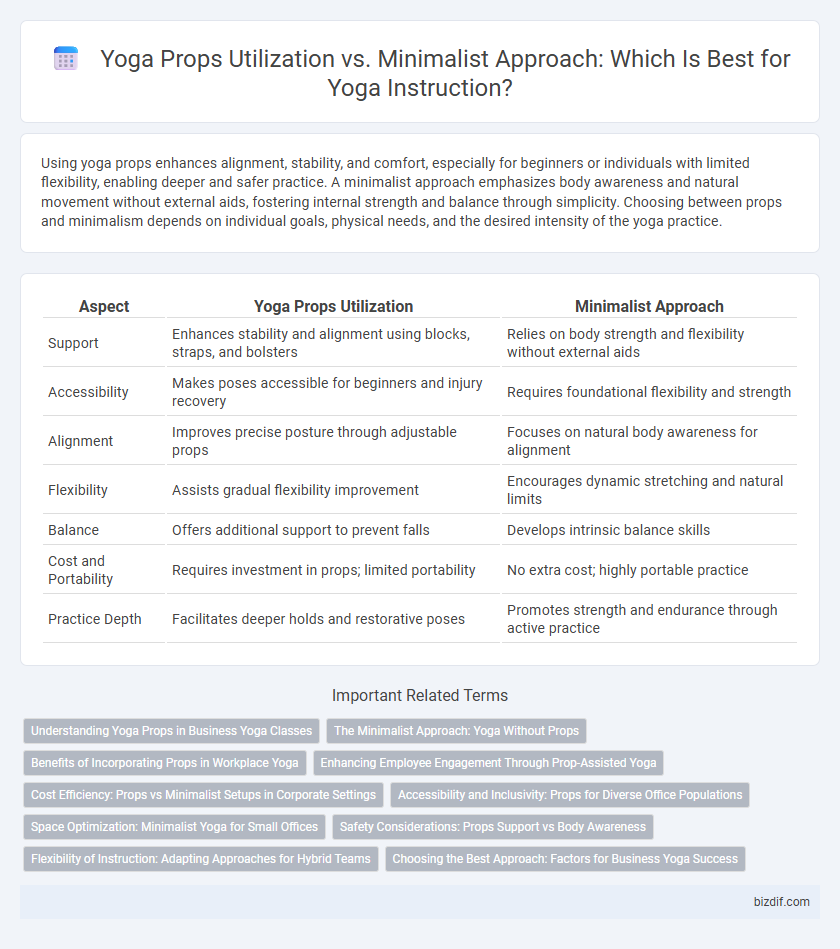Using yoga props enhances alignment, stability, and comfort, especially for beginners or individuals with limited flexibility, enabling deeper and safer practice. A minimalist approach emphasizes body awareness and natural movement without external aids, fostering internal strength and balance through simplicity. Choosing between props and minimalism depends on individual goals, physical needs, and the desired intensity of the yoga practice.
Table of Comparison
| Aspect | Yoga Props Utilization | Minimalist Approach |
|---|---|---|
| Support | Enhances stability and alignment using blocks, straps, and bolsters | Relies on body strength and flexibility without external aids |
| Accessibility | Makes poses accessible for beginners and injury recovery | Requires foundational flexibility and strength |
| Alignment | Improves precise posture through adjustable props | Focuses on natural body awareness for alignment |
| Flexibility | Assists gradual flexibility improvement | Encourages dynamic stretching and natural limits |
| Balance | Offers additional support to prevent falls | Develops intrinsic balance skills |
| Cost and Portability | Requires investment in props; limited portability | No extra cost; highly portable practice |
| Practice Depth | Facilitates deeper holds and restorative poses | Promotes strength and endurance through active practice |
Understanding Yoga Props in Business Yoga Classes
In business yoga classes, understanding the strategic use of yoga props like blocks, straps, and bolsters enhances alignment, accessibility, and client satisfaction while supporting diverse skill levels. A minimalist approach emphasizes natural body movement and increased strength without dependence on props, appealing to experienced practitioners seeking challenge and mindfulness. Balancing prop utilization and minimalism can optimize class inclusivity and retention, driving successful yoga business outcomes.
The Minimalist Approach: Yoga Without Props
The minimalist approach to yoga emphasizes practicing poses using only the body's natural alignment and strength, promoting deeper awareness and balance without reliance on external props. This method enhances flexibility and mindfulness by encouraging practitioners to listen closely to their body's signals, fostering intrinsic stability and control. By eliminating props, yoga becomes accessible anywhere, reinforcing the practice as an internal journey rather than dependent on physical supports.
Benefits of Incorporating Props in Workplace Yoga
Incorporating yoga props such as blocks, straps, and bolsters in workplace yoga enhances alignment, reduces strain, and accommodates varying flexibility levels, leading to safer practice and increased employee comfort. Props facilitate deeper stretches and better posture, which contribute to reduced musculoskeletal discomfort commonly experienced during desk work. Utilizing these tools can improve focus and relaxation, promoting overall wellness and productivity in the office environment.
Enhancing Employee Engagement Through Prop-Assisted Yoga
Prop-assisted yoga enhances employee engagement by providing support that improves posture, alignment, and comfort during practice, leading to reduced physical strain and increased focus. Utilizing blocks, straps, and bolsters allows employees of varying skill levels to participate confidently, fostering inclusivity and sustained interest. This approach contrasts with minimalist yoga, where limited support may challenge beginners and reduce overall engagement in workplace wellness programs.
Cost Efficiency: Props vs Minimalist Setups in Corporate Settings
Yoga props like blocks, straps, and bolsters enhance alignment and accessibility, which can reduce injury risk and improve employee participation in corporate wellness programs. Minimalist setups relying on bodyweight and floor mats lower upfront equipment costs and simplify space requirements, making them more scalable and budget-friendly for large organizations. Evaluating cost efficiency, corporate settings benefit from a balanced approach that maximizes engagement through selective prop use while maintaining overall low expenditure.
Accessibility and Inclusivity: Props for Diverse Office Populations
Yoga props such as blocks, straps, and bolsters enhance accessibility by accommodating diverse body types and mobility levels in office yoga sessions. Incorporating these tools ensures inclusivity, allowing employees with varying physical abilities to engage comfortably and safely. A minimalist approach may limit participation, whereas props foster a supportive environment for all practitioners regardless of flexibility or experience.
Space Optimization: Minimalist Yoga for Small Offices
Utilizing yoga props enhances alignment and support, yet minimalist yoga emphasizes efficient use of limited space, critical for small office environments. Compact practices rely on body awareness and breath control, reducing dependence on mats or blocks to optimize floor area. Integrating minimal props like straps or cushions maintains practice effectiveness while preserving workspace functionality in confined settings.
Safety Considerations: Props Support vs Body Awareness
Using yoga props such as blocks, straps, and bolsters enhances safety by providing additional support and stability, reducing the risk of injury, especially for beginners or those with limited flexibility. In contrast, a minimalist approach prioritizes developing body awareness and intrinsic strength, which can foster long-term injury prevention but may increase the risk of strain without proper guidance. Balancing props utilization with mindful body alignment promotes safe practice by accommodating individual needs while encouraging internal proprioception.
Flexibility of Instruction: Adapting Approaches for Hybrid Teams
Yoga instruction benefits from the flexibility of integrating both props utilization and a minimalist approach, allowing seamless adaptation for hybrid teams with varied practice environments. Incorporating blocks, straps, and bolsters enhances alignment and accessibility, while minimalist instruction encourages embodiment and deeper proprioceptive awareness without reliance on equipment. Tailoring these methods fosters inclusivity and personalized progression, optimizing engagement whether in-person or remote.
Choosing the Best Approach: Factors for Business Yoga Success
Choosing between yoga props utilization and a minimalist approach depends on factors such as client demographics, class objectives, and space constraints. Utilizing props like blocks, straps, and bolsters enhances accessibility and alignment, appealing to beginners and restorative yoga practitioners. Conversely, a minimalist approach fosters body awareness and balance, attracting advanced students and streamlining operational costs for yoga studios.
Yoga Props Utilization vs Minimalist Approach Infographic

 bizdif.com
bizdif.com